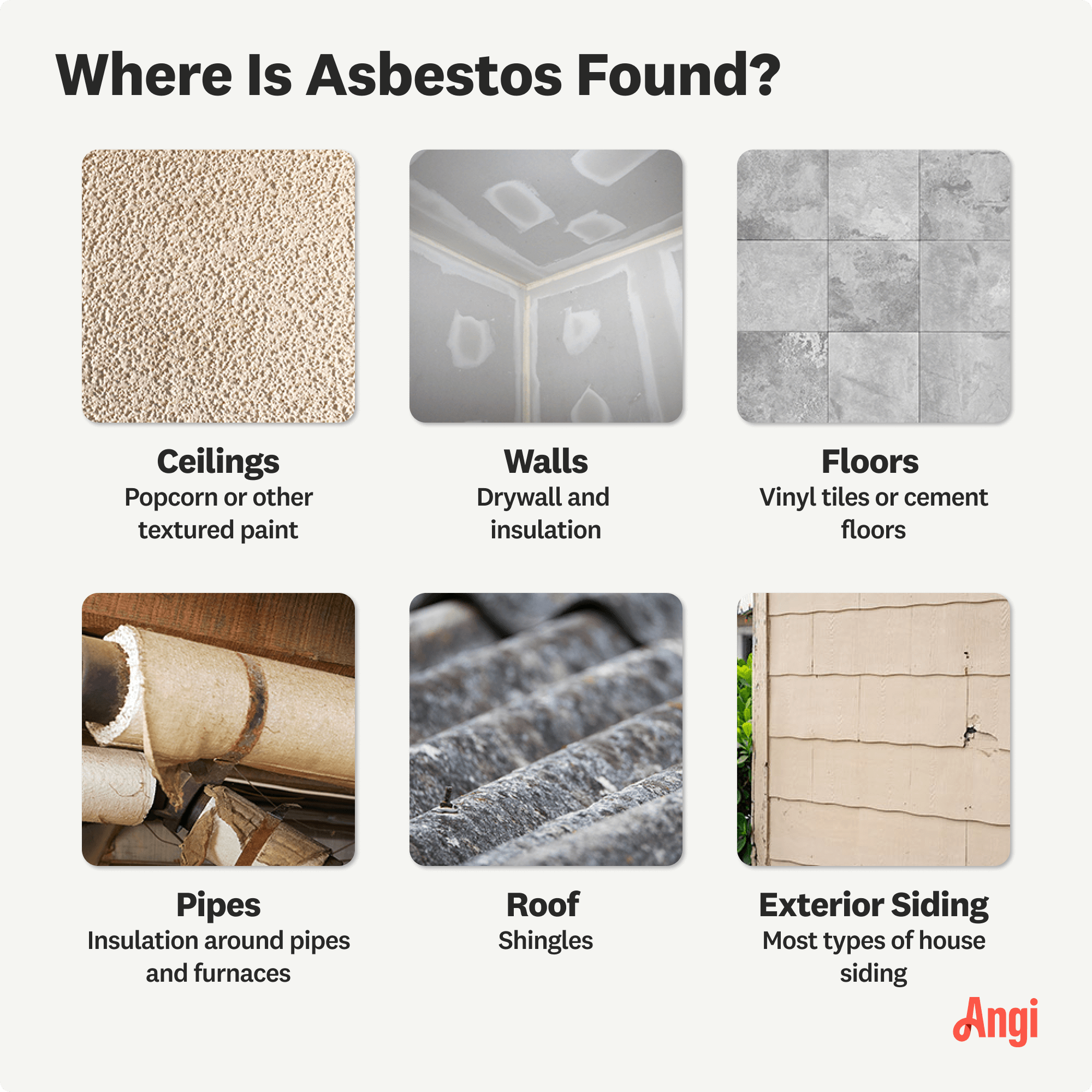
The cost of asbestos testing varies based on location, property size, test type, and other factors. Here’s a breakdown of the costs to conduct an asbestos survey.
Asbestos may lurk in the building materials of older homes


Homes built in the 1980s or earlier may have building materials that contain asbestos.
Asbestos is a mineral fiber that can cause health issues if inhaled.
Often, it’s best to leave asbestos untouched.
Older homes have their charms—and some drawbacks. The materials used to build houses decades ago may have been durable, but some also contained asbestos, which is dangerous if disturbed. If your home was built in the 1980s or earlier, knowing where asbestos is found will help protect your health. Common places you may find asbestos include insulation, roofing, flooring, ceilings, and walls. Here’s what to know about where asbestos may be lingering in your older home.
Asbestos are mineral fibers that resist heat and corrosion. Since they can withstand high temperatures and don't corrode, they have long been a popular choice for use in materials that need to be fireproof or corrosion-resistant, including many types of building materials.
Six types of asbestos exist, and each type has its own distinct uses. The fiber shape can be either serpentine, which looks like long and curly spirals, or amphibole, which looks like stiff, short needles.
Asbestos was a common ingredient in older building materials for two reasons.
First, it is fire resistant, allowing it to help reduce fire risk in homes. Second, it has excellent insulation properties, helping to keep homes warm in the winter or cool in the summer. It also excels at sound insulation, so noise is less likely to travel from room to room.
Additionally, asbestos can resist water, chemicals, and electricity. It may seem like a miracle mineral, but it has a serious downside.
If your home was built before the 1970s, there’s a chance some of the building materials used contain asbestos. You'll need to hire a pro to detect for any asbestos.

First, if you live in a newer home, one built in the late 1980s or after, it's highly unlikely that you'll find asbestos in any materials in your house. Recognizing the health risks of the fibers, the Environmental Protection Agency (EPA) banned certain uses of asbestos in 1989.
However, if your home was built before then, particularly during the 1930s to 1950s, there is likely asbestos in some areas.
Some of the most common places where asbestos may be found include:
Pipe insulation
Roof materials
Popcorn ceilings
Ceiling Tiles
Drywall or paperboard
Cement
Depending on the age of your home and the materials it contains, there may be asbestos lurking elsewhere. For example, if your toilet is on the older side, it could contain asbestos.
According to data from Angi customers, the most common materials found with asbestos are flooring (28.9%), walls and ceilings (19.5%), and insulation (14.4%). Other materials people need asbestos removal for include siding, sprayed acoustic ceiling, and drywall compound. Asbestos can cause serious respiratory problems, so if you even slightly suspect there’s asbestos in your home, contact a removal company as soon as you can.
Unfortunately, you can't look at a piece of drywall or a floor tile and tell if it contains asbestos with the naked eye. To identify the fiber, you need to use a polarized light microscope, which you'll typically only find in a lab. You also need to know what to look for, which requires years of training and expertise.
You need to hire a local asbestos testing company to take samples and analyze them with a special microscope. Since there are health risks associated with handling asbestos and releasing the fibers, taking the samples and analyzing them is definitely something you should leave to the pros.

Exposure to asbestos can increase your risk of respiratory problems, notably lung cancer and mesothelioma, a type of cancer that develops as a direct result of asbestos exposure. Mesothelioma can affect the lungs or abdomen.
Another condition that can develop after exposure to asbestos is asbestosis, which causes scarring in the lungs.
That sounds scary, but don't be too worried. Lung problems and cancer typically develop after regular, prolonged exposure to asbestos, such as after years of working in a mine or handling asbestos-containing materials without wearing protective equipment.
Mesothelioma and asbestosis are both rare conditions—mesothelioma affects about 3,000 people annually. Typically, it takes at least 10 years after prolonged exposure to asbestos for a health concern to develop.
If you suspect material in your home contains asbestos, the best thing to do is usually nothing. As long as the material is in good condition, the risk of exposure and health effects is low.
Asbestos becomes a health concern once it is disturbed and its fibers become airborne. You can then breathe in the fibers, which can remain in your lungs. So, if you have a popcorn ceiling in one room and would like to remove it, or have vinyl tiles in another room of unknown age and origin and you want to redo the floor, that's when you should call in a professional to take a sample and send it out for asbestos testing.
The average asbestos testing cost is $480, with the total price depending on your location, the size of your home, and the extent of the issue.
If a material that may contain asbestos becomes damaged, you'll want to take action. For example, if you drill into asbestos-containing drywall or a popcorn ceiling starts to flake away, the asbestos fibers can come loose. Limit access to the area until a professional can investigate the material.
Finally, if you're considering a large-scale renovation or remodel of your home, and you have reason to believe asbestos is present, call in a professional asbestos testing company before the project begins. If asbestos is present, the company may recommend sealing or covering the material to prevent the release of the fibers, or removing the asbestos-containing materials entirely. A local asbestos abatement company can safely remove it from your home and then properly dispose of it.
Removal is often more expensive than containment, with the average cost of asbestos removal starting at over $1,000.
Andy’s services removed my concrete driveway and installed pavers. His crew and Andy himself were amazing. They were friendly, knowledgeable, punctual, A+ on communication and fairly priced. I enjoyed working with his team and I ended up hiring them for another job. I also plan on using them...
Excellent service. Technician was extremely professional and courteous.
I recently had the privilege of working with Environmental Services of America for an asbestos removal project involving siding in Atlanta, GA. Their professionalism, expertise, and commitment to excellence were evident throughout the entire process. Their exceptional knowledge and meticulous...
I cannot say enough to properly express my satisfaction in working with Golden Master. I have a property that I cannot easily access. They went to the place, made an assessment, and performed the work perfectly. The fees were competitive. Later, the house had a different problem. They came...
I hired them to help me move furniture from my home to garage so I can donate it. They were punctual, professional and speedy. I will absolutely use them again.
They were wonderful. They were on time. They painted the whole inside of my home. All of the room. Two rooms with wall paper they remove that. Amazing job. I recommend them for any job that you need. My house got sold!
Terry was very knowledgeable and dedicated: He made sure my sprinkler system was up and working properly even though the temperature that day was close to 100 degrees. I appreciate the kindness and dedication and will use him again.
I used Top Roof to repair our leaky shingle roof and had a great experience with them. Top Roof and his team were very nice to deal with, performed quality work in a timely fashion, and at a very competitive price. I appreciate as a customer. I would call again for any roofing needs and...
I would never do it again and will make sure everyone know that HomeAdvisor should remove them from the list of professional. I trusted HomeAdvisor so I didn't dig as deep as I should with this choice.
They successfully installed a new, energy efficient water heater. They were very responsive in answering all my questions and scheduling the time to replace the heater. I live in an older condo building downtown and the heater was very difficult to install due to tight quarters, but they did...
From average costs to expert advice, get all the answers you need to get your job done.

The cost of asbestos testing varies based on location, property size, test type, and other factors. Here’s a breakdown of the costs to conduct an asbestos survey.

Asbestos removal costs vary based on where it’s located, the size of the job, and if there is any underlying damage. Learn what has the biggest effect on the cost.

Discover the cost to remove asbestos siding, including average prices, key cost factors, and tips to help homeowners plan a safe and budget-friendly project.

In some circumstances, sealing asbestos may be the way to go, rather than removal. Read on to learn how to encapsulate asbestos pipe insulation.

Understanding the difference between asbestos siding versus fiber cement siding lets you recognize dangerous asbestos material. Learn how to spot the differences.

Knowing how to clean asbestos can ensure that you, your family and your neighbors remain safe when working with materials that could contain asbestos.